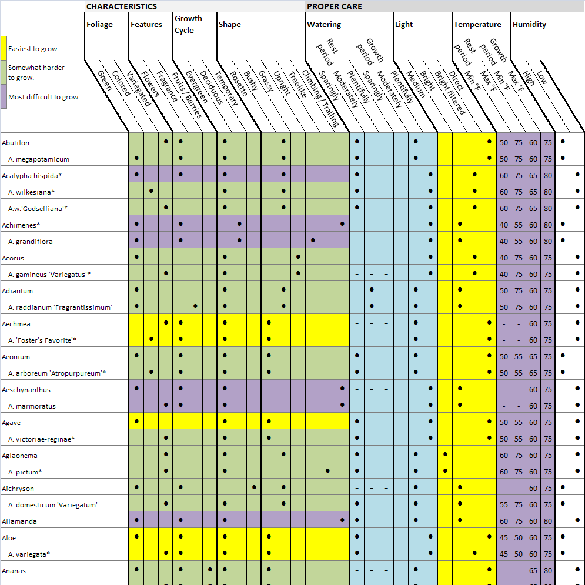Plant List & Reference Guide
The following chart is designed to provide a quick reference to important features of indoor plants, as well as to vital aspects of their cultivation needs. By examining this chart you can get a preliminary idea of which plants are most likely to fit into specific positions for decorative purposes, and whether or not a given plant is appropriate for the growing conditions available in any such position.
If you want to skip all the verbiage, you can go straight to the high resolution image.
Each entry relates to a particular genus. In cases, however, where certain species look very different from the rest or require a different kind of care, those species are treated separately from the genus to which they belong. Occasionally more than one species fits this secondary description. In such cases only one species is mentioned but it is followed by an asterisk (*).

A few additional comments about the above guide:
- The word “foliage” is used here to cover not only leaves but also the stems of such leafless plants as cacti.
- The guide to plant shape is a rough indicator since plants are so variable in form that precise classification is virtually impossible. Therefore, most creeping plants are listed below as “climbing / trailing,” and “bushy” refers to the general look of a plant rather than to whether or not it literally fits the accepted definition of the word “bush”. Descriptions of some plants (for instance, “globular” for many cacti) are self-explanatory.
- Many plants change their appearance as they age. Some palms, for example, become tall and upright after a period of bushy, lower growth. Descriptive terms in this chart normally apply to plants of the size most frequently available in garden stores and nurseries.
- Watering instructions and maximum and minimum recommended temperatures are usually given for both active growth and rest periods. Rest-period recommendations are omitted, however, for plants that grow actively throughout the year in normal room conditions.



Leave a Reply